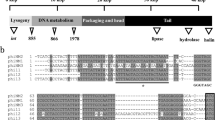Summary
Transformations of two linked ribosomal loci (str and ery) were carried out between the SIII-1 strain of pneumococcus and the Challis and SBE strains of group H streptococcus. Transfer of markers between the Challis and SBE strains is as efficient as in the corresponding intrastrain transformations. Transfer between either of these strains and the pneumococcus, however, is less efficient than in the corresponding intrastrain transformation, and is referred to as heterospecific transformation. The inefficiency of the heterospecific transformation is due neither to specific lethality nor reduced uptake of heterologous DNA.
When DNA was extracted from the hybrid resulting from a heterospecific cross and used to transform the original donor and recipient species, we found: (a) no donor material in the hybrid DNA responsible for the markedly low efficiency of integration into the recipient species; (b) donor material, in addition to the transforming marker itself, detectable by the higher efficiency with which hybrid DNA transforms the original donor species than does DNA from the original recipient species.
DNA was extracted from each of 36 independently derived, doubly marked transformants resulting from the cross: Challis str-s ery-sxSIII-1 str-r53 ery-r2 DNA. Variability was observed between the different hybrid DNAs when the integration efficiency of the str marker in each DNA was compared with that of the ery marker. Variability of as great a magnitude was not observed when the same hybrid DNA was tested in repeated experiments, or when different DNA preparations were extracted from the same hybrid strain, or when several DNA preparations were obtained from a number of independent homospecific transformants. It is concluded that different kinds of donor material are present in the various hybrids, and that the nature of this extra-marker material affects the integration of the marker.
Linkage of the str and ery markers was reduced in heterospecific transformations. The kind of donor DNA in the hybrid genome did not affect the linkage reduction observed when the str and ery markers were transferred back to the donor species in which they originated. Indeed, this linkage reduction was the same as that observed when the markers were originally transferred from the SIII-1 to the Challis strain. Specific factors reducing linkage in heterologous crosses must, therefore, be distinct from other factors which affect integration efficiency. The former, however, may be primarily responsible for the inefficiency of heterospecific transformation.
One of the hybrid DNAs was used to obtain a second generation of hybrids by passing it through each of the original parental strains. Tests of the DNAs extracted from 24 independently produced, second-generation hybrids showed that hybrid DNA is subject to further alteration by a second integration involving some heterologous confrontation. The probability of such alteration appears to be increased if the second integration is accompanied by linkage reduction.
Similar content being viewed by others
References
Arber, W., Linn, S.: DNA modification and restriction. Ann. Rev. Biochem. 38, 467 (1969).
Chen, K. C., Ravin, A. W.: Heterospecific transformation of pneumococcus and streptococcus. I. Relative efficiency and specificity of DNA helping effect. J. molec. Biol. 22, 109 (1966a).
— II. Dependence of relative efficiency of marker integration on host genome. J. molec. Biol. 22, 123 (1966b).
Coleman, S. E., Van de Rijn, I., Bleiweis, A. S.: Lysis of streptococcus by lysozyme for preparation of transforming DNA. Bact. Proc. p. 48 (1970).
Ephrussi-Taylor, H., Sicard, A. M., Kamen, R.: Genetic recombination in DNA-induced transformations of pneumococcus. I. The problem of relative efficiency of transforming factors. Genetics 51, 455 (1965).
Goodgal, S.: Studies on transformation of Hemophilus influenczae. IV. Linked and unlinked transformations. J. gen. Physiol. 45, 205 (1961).
Green, D. M.: A host specific variation affecting relative frequency of transformation of two markers in Pneumococcus. Exp. Cell Res. 18, 466 (1959).
Hotchkiss, R. D.: Characterization of nucleic acids by spectrophotometry. Methods in enzymology. III. (S. P. Colowick and N. O. Kaplan, eds.), p. 708 (1957).
—, Evans, A. H.: Analysis of the complex sulfonamide resistance locus of pneumococcus. Cold Spr. Harb. Symp. quant. Biol. 23, 85 (1958).
Iyer, V. N., Ravin, A. W.: Integration and expression of different lengths of DNA during the transformation of pneumococcus to erythromycin resistance. Genetics 47, 1355 (1962).
Lacks, S.: Integration efficiency and genetic recombination in pneumococcal transformation. Genetics 53, 207 (1966).
Ravin, A. W.: Intergenic and intragenic recombination in DNA-induced transformation. Proc. of Symp. on the Mutational Process. Czechoslovak Academy of Sciences, Prague. (1965).
— Chen, K. C.: Heterospecific transformation of pneumococcus and streptococcus. III. Reduction of linkage. Genetics 57, 851 (1967).
— De Sa, J. D. H.: Genetic linkage of mutational sites affecting similar characters in Pneumococcus and Streptococcus. J. Bact. 87, 86 (1964).
—, Iyer, V. N.: Genetic mapping of DNA: influence of the mutated configuration on the frequency of recombination along the length of the molecule. Genetics 47, 1369 (1962).
Rotheim, M. B.: A genetic factor on the DNA molecule capable of depressing the frequency of transformation at a linked site. Genetics 47, 599 (1962).
— Ravin, A. W.: The mapping of genetic loci affecting streptomycin resistance in Pneumococcus. Genetics 46, 1619 (1961).
Rytir, V., Ma, M., Ravin, A. W.: Effect of ionic strength on reversible DNA inactivation and on the helping effect in transformation. Bact. Proc. p. 48 (1970).
Schaeffer, P.: L'inhibition de la transformation comme moyen de mesure de la “compétence” bactérienne. C. R. Acad. Sci. (Paris) 245, 451 (1957).
— Interspecific reactions in bacterial transformations. Symp. Soc. exp. Biol. 12, 60 (1958).
Steinhart, W. L., Herriott, R. M.: Genetic integration in the heterospecific transformation of Hemophilus influenzae cells by Hemophilus parainfluenzae deoxyribonucleic acid. J. Bact. 96, 1725 (1968).
Author information
Authors and Affiliations
Additional information
Communicated by E. Witkin
Supported by NIH grant AI-00917.
Rights and permissions
About this article
Cite this article
Biswas, G.D., Ravin, A.W. Heterospecific transformation of Pneumococcus and Streptococcus . Molec. Gen. Genet. 110, 1–22 (1971). https://doi.org/10.1007/BF00276040
Received:
Issue Date:
DOI: https://doi.org/10.1007/BF00276040




